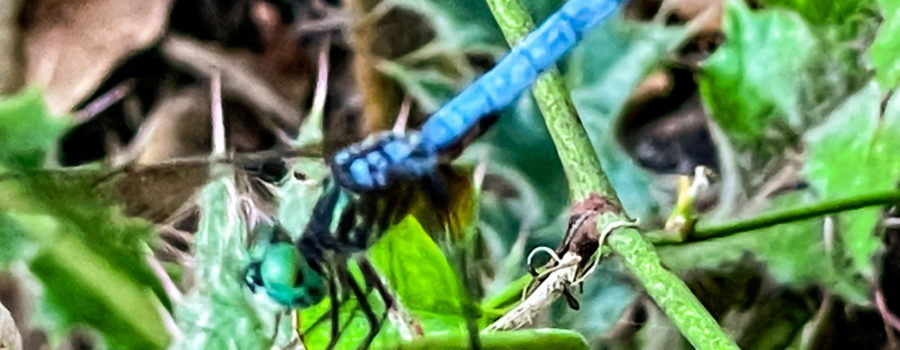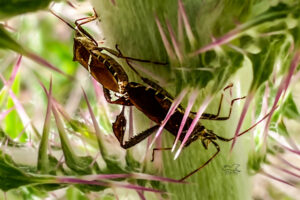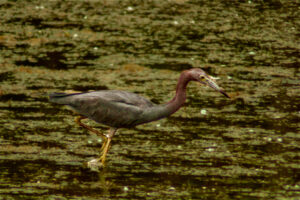The Blue Dasher is a Beautiful Fall Visitor
For the last few weeks in the afternoon when I come home I have had a dragonfly or two hanging around my gate and mailbox area. These guys are notably smaller than the female Eastern pondhawks which are the main dragonflies that I see here. They are also pretty fast and more shy than the pondhawks, so trying to photograph them has been a challenge. They aren’t out there every day, either, so of course I’m most likely to see them when I’ve gotten out of the truck to get the mail and open the gate without bringing my camera! And that’s exactly what happened the other day. I was getting the mail and one finally perched on a branch of the summer grape that grows on the fence. It actually stayed there for a relatively long period, so I raced over to the truck and grabbed my camera. Of course, it was gone in the few seconds that took, but it actually came right back and perched again! With a slow, quiet approach, it actually let me get close enough to snap a couple shots. Then off it went, but not too far, so we played out the whole scenario again. And actually a third time before it finally disappeared completely. Although the photos I got were not ones that I’m absolutely thrilled with (and most of them were downright awful), I think they may be all I’m going to get this year. I’ve not seen any dragonflies around the gate now for over a week, so I suspect they’ve moved on.

This beautiful, speedily little dragonfly is a blue dasher (Pachydiplax longipennis), also sometimes called a blue pirate or a swift long-winged skimmer. It’s a member of the skimmer family (surprise!), which is the largest family of dragonflies, but it is the only member of it’s genus, Pachydiplax. The blue dasher is one of the most common dragonflies in North America and can be found all over the continental United States except in the Dakotas and in the Rocky Mountains. It’s also found in much of southern Canada, all of Mexico, and in the Bahamas. Being so common, it’s one of the best studied dragonflies. Like most dragonflies, it tends to live around bodies of water. In this case, it prefers still or slow moving water like ponds, lakes, wetlands, ditches, and slow moving streams. For this reason, I was rather surprised to find it up here in the sandhills. I thought maybe my ponds had attracted it, and that may be the case, but in my research, I also learned that the males are pretty aggressive and that smaller males are sometimes driven away from the water into other areas. I don’t recall seeing these guys around before, but I also have not always been as observant as I should be. Next summer I will keep my eyes open so that perhaps I can solve the mystery.
This particular individual in the photos is a male. This species is sexually dimorphic, so the males and females can easily be told apart. The males, like this fellow, tend to be a powdery blue with a black tip on their abdomens, while the females are darker with parallel yellow stripes on the abdomen. Juvenile males may look a lot like females, but it would be highly unusual to see a juvenile this late in the year. Not only are these dragonflies territorial and aggressive towards each other (especially the males), but they are also aggressive hunters. They eat other flying insects, mostly smaller ones like mosquitoes, flies, flying ants, termites and moths. They hunt by perching and waiting for unsuspecting prey to fly by and darting out after them. They are voracious eaters, and will consume hundreds of small insects each day. The nymphs are also great eaters and consume mosquito larvae and other small aquatic organisms. For this reason, I hope that I will be seeing more blue dashers around here next year. A few less mosquitoes anywhere in central Florida is always a good thing!

If you enjoy beautiful nature photography and artwork along with intriguing and informative content about nature, wildlife, and animals then you’ll love this blog. Be the first to get new episodes by subscribing to our mailing list! It’s easy and free.




Recent Comments